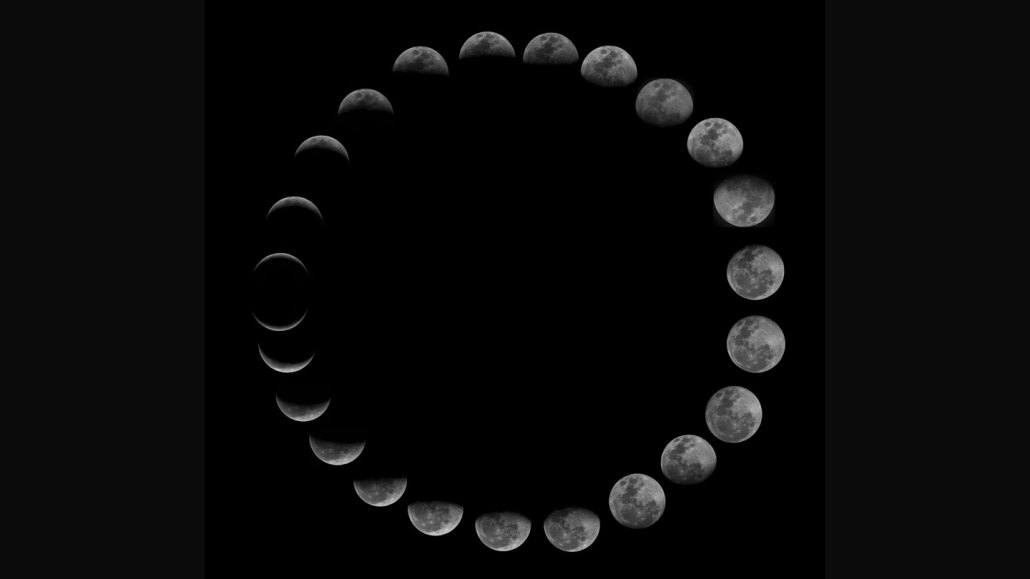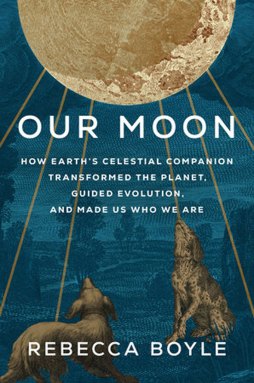
Various societies have used the phases of the moon (shown in this composite image) to track time.
Yaorusheng/Moment/Getty Images

Our Moon
Rebecca Boyle
Random House, $28.99
Science journalist Rebecca Boyle has an intergenerational connection with the moon. Her grandfather Pfc. John J. Corcoran was involved in the 1943 Battle of Tarawa on the namesake atoll in the Pacific Ocean during World War II. The United States’ narrow victory against Japan came at heavy human cost. One reason: A weak high tide forced American soldiers to wade through the ocean into Japanese gunfire rather than sail their boats to meet their enemies.
Historians blame the moon for the massive casualties — the battle occurred during a time of month when the sun’s and moon’s gravitational tugs partially cancel each other out, contributing to the lower-than-usual high tide.
Boyle, however, recognizes that the moon’s impact on humankind is far more vast and multifaceted. After all, the moon helped shape Earth into the home we know, she writes in her new book, Our Moon. At the outset, Boyle promises to convince readers of the moon’s extensive influences, both biological and spiritual. Over nearly 300 pages, she delivers.
Naturally, the book touches on well-known subjects, including the Apollo missions that brought humans to the lunar surface (SN: 2/18/22). Still, the book is guaranteed to surprise, filled with factoid gold that will enthrall geologists, moon nerds and casual readers alike. For instance, Boyle incorporates new research on how the moon formed 4.5 billion years ago, pointing to geologic evidence that may still be entombed deep within Earth’s mantle (SN: 11/1/23). And contrary to what Apollo photos suggest, the moon’s surface sparkles with technicolor hues, astronauts reported. “The Moon was not gray, but a landscape flecked with color,” Boyle writes. “Analysis of the Moon rocks has since found volcanic glass in every color of the spectrum.”
And then there are the ways the moon has influenced life on Earth. The tides pulled our ocean-confined ancestors out of the water. Extremes between high and low tides in the distant past kept beaching marine life; those that could breathe in air or developed limbs for walking became the earliest landlubbers. Acting as a mini counterweight to the Earth’s own heft, the moon has kept our planet’s axis from lurching all over the place, thereby preventing extreme climate swings over millennia. The moon also inspired the first religions, and its study spawned the first science.
Boyle packs in an impressive amount of information. But instead of throwing details at the reader, she packages them into imagined experiences of a lunar visitor. The result is a rich travelog that makes the moon’s sensations visceral, down to its acrid smell and the hay fever you’d get from exposure to pesky lunar dust (SN: 12/3/13). Early humans brought the distant moon down to Earth through patient observation and art. Now, Boyle brings readers up there.
With much ground to cover, she divides the book into three sections: the moon’s making, its cultural footprint and how modern society recast the moon in a new light. Rather than adhering to a strict chronology, Boyle roams under these three broad umbrellas. Her discussions within each section come in palatable bite sizes and swing between the ancient and modern, culture and science.
That masterful weaving is on display when Boyle recounts the moon’s role in keeping track of time (SN: 7/9/19). “Time confers power to whoever commands it,” she writes, and it remains “the simplest and most predictable way to seize that command.” Stone Age Scots, Mesopotamians and Native Americans understood the power of the lunar cycles, and they erected monuments to track the moon’s trek across the sky. But around 45 B.C., Julius Caesar designed a calendar that banished the moon from its timekeeping duties. Now, society mostly looks to the sun as our daily metronome.
Today, we’re at another juncture where the moon might further drop from its standing of reverence and communion. Soon, astronauts will return there, with the United States, China and other countries scoping out landing sites (SN: 11/16/22). Instead of being endeavors for the benefit of all humankind, these explorations will probably be a nationalistic race for scientific real estate, Boyle warns. Our heavenly neighbor is also being eyed as a mining outpost, a junkyard, a waystation for deep space travel or a settlement destination. The moon, she worries, may fall into the ravenous maw of capitalism.
Still, the moon is more than just another target for humankind’s material ambitions. Our Moon reminds us that our “silvery sister” has given us our habitable climate, sciences and cultures. These gifts are more than enough; they are priceless.
Buy Our Moon from Bookshop.org. Science News is a Bookshop.org affiliate and will earn a commission on purchases made from links in this article.







